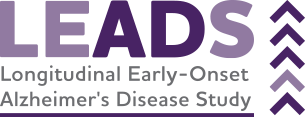LEADS Primary Aims
Aim 1: To compare the baseline and longitudinal cognitive and functional characteristics of EOAD compared to LOAD and identify optimal outcome measures for clinical trials.
H1a: Controlling for performance on episodic memory tests, EOAD will show greater impairment in executive, language and visuospatial function compared to ADNI LOAD. H1b: EOAD will show more rapid decline on MMSE, ADAS-Cog and CDR-SB compared to ADNI LOAD. H1c: A data-driven analysis of functional ratings and psychometric test scores will identify measures more sensitive to change over time in the full spectrum of EOAD (amnestic and non-amnestic subtypes) than existing composite measures (ADAS-Cog and CDR-SB), leading to a new EOAD composite outcome measure for use in future clinical trials and observational studies.
Aim 2: To compare baseline and longitudinal MRI, amyloid PET, tau PET, CSF and plasma ATN measures between EOAD and LOAD and identify optimal outcome measures for clinical trials.
H2a: EOAD will show greater baseline and longitudinal changes in cortical gray matter atrophy and tau burden than matched ADNI LOAD subjects, but no differences in baseline or longitudinal amyloid PET, plasma or CSF measures. H2b: Baseline and longitudinal change in cortical tau, gray matter atrophy, CSF and plasma measures will correlate with baseline and longitudinal measures of cognitive function. H2c: Through a data-driven approach we will identify composite biomarker measures that optimally capture change over time, leading to EOAD composite imaging outcomes for use in future clinical trials and observational studies.
Aim 3: To investigate the influence of APOE genotype on baseline and longitudinal imaging biomarkers and clinical phenotype in EOAD.
H3a: Atypical subtypes of EOAD (PPA, PCA) will show a lower APOE e4 carrier rate than memory predominant EOAD. H3b: Relative to non-carriers, APOE e4 carriers will demonstrate greater baseline and longitudinal change in medial temporal atrophy and tau PET signal. H3c: EOnonAD will show a significantly lower APOE e4 carrier rate than EOAD.
Exploratory Aim 4: To characterize genetic contributions to EOAD and obtain annually an array of uniformly collected biospecimens for future biomarker development.
H4a: A subset of EOAD will have mutations in genes known to contribute to AD. H4b: A subset of EOnonAD will have mutations in genes known to contribute to FTLD. H4c: Next generation sequencing will identify novel genes in EOAD involved in Aβ, tau, inflammation, and lipid processing pathways.
Aim 5: To characterize demographic, clinical, neuroimaging, and fluid biomarker measures in EOnonAD cases to explore the possible etiologies of cognitive impairment.
H5a. EOnonAD participants will show MRI and/or FDG PET patterns that are either supportive of a nonAD neurodegenerative disease or suggestive of non-neurodegenerative etiology. H5b. Frontotemporal atrophy and hypometabolism and elevated plasma neurofilament light (NfL) will predict transition to an FTD spectrum diagnosis over time. H5c. Data-driven analyses of EOnonAD clinical and biomarker assessments will identify clusters suggestive of potential etiologies, which will be confirmed at autopsy.
Aim 6: To follow all patients to autopsy and perform neuropathologic analyses of postmortem brain tissue to identify the pathophysiologic substrate and comorbid pathologies in EOAD and EOnonAD cases.
H6a. Neuroimaging and fluid biomarkers collected during life in EOAD/EOnonAD cases will correlate with postmortem neuropathologic changes, which will be the basis for prediction models.

